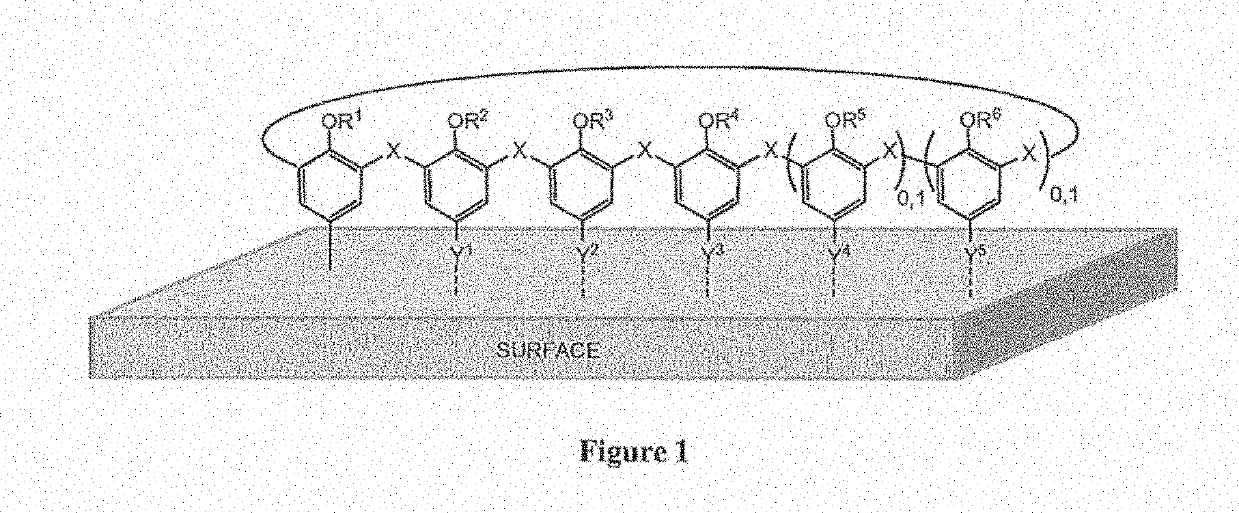Materials coated with calixarenes
a technology of calixarenes and aryl radicals, applied in the field of calixarenes coated materials, can solve the problems of high reactive aryl radicals, complex structure, and inability to fully realize the effect of the surface, and achieve the effect of easy post-functionalization of the surfa
- Summary
- Abstract
- Description
- Claims
- Application Information
AI Technical Summary
Benefits of technology
Problems solved by technology
Method used
Image
Examples
example 1
and Characterization of Calix[4]Arene Tris-O-Propyl 59
[0125]
[0126]p-tbutyl-calix[4]arene, X4H4 19 (5.01 g, 7.72 mmol, 1 equiv.), Ba(OH)2.8H2O (7.42 g, 0.0235 mol, 3 equiv.) and BaO (5.54 g, 0.0361 mol, 4.7 equiv.) were suspended in DMF (190 mL). 1-bromopropane (35 mL, 0.385 mol, 50 equiv.) was added and the reaction mixture was stirred for 2 h30 at 30° C. under inert atmosphere. The mixture reaction was concentrated under reduced pressure and dissolved in CH2Cl2 (300 mL). The organic layer was washed with H2O (4×200 mL) and combined aqueous layers were extracted with CH2Cl2 (2×250 mL). The combined organic layers were concentrated under reduced pressure to yield compound 59 as a white solid (5.6645 g, 7.31 mmol, 95%) which was characterized as follows:
[0127]1H NMR (300 MHz, CDCl3, 298K): δ (ppm)=0.82 (s, 18H, tBu), 0.95 (t, 3J=7.5 Hz, 3H, CH2CH3), 1.09 (t, 3J=7.4 Hz, 6H, CH2CH3), 1.32 (s, 9H, tBu), 1.34 (s, 9H, tBu), 1.81-2.01 (mult, 4H, CH2CH3), 2.33 (mult, 2H, CH2CH3), 3.16 (d, 2J...
example 2
and Characterization of Calix[4]Arene Tetra-O-n-Propyl 60
[0128]
[0129]Calix[4]arene tris-O-propyl 59 (0.506 g, 0.653 mmol, 1 equiv.) and NaH (60% in oil, 0.154 g, 3.85 mmol, 6 equiv.) were suspended in DMF (20 mL). 1-bromopropane (1.2 mL, 0.0132 mol, 20 equiv.) was added and the mixture reaction was stirred for 2 h at 30° C. under inert atmosphere. The mixture reaction was concentrated under reduced pressure and dissolved in CH2Cl2 (50 mL). The organic layer was washed with H2O (3×20 mL) and combined aqueous layers were extracted with CH2Cl2 (2×30 mL). The combined organic layers were concentrated under reduced pressure to yield compound 60 as a white solid (0.548 g, 0.653 mmol, 100%) which was characterized as follows:
[0130]1H NMR (300 MHz, CDCl3, 298K): δ (ppm)=1.02 (t, 3J=7.5 Hz, 12H, CH2CH3), 1.10 (s, 36H, tBu), 2.05 (mult, 8H, CH2CH3), 3.13 (d, 2J=14.0 Hz, 4H, ArCH2 eq), 3.84 (t, 3J=7.8 Hz, 8H, OCH2), 4.44 (d, 2J=12.6 Hz, 4H, ArCH2 ax), 6.80 (s, 8H, ArH).
Example 3—Synthesis and ...
example 9
and Characterization of Calix[4]Arene Tetra-O-(Ethyl Acetate) 67
[0168]
[0169]p-tbutyl-calix[4]arene, X4H4 19 (1.021 g, 1.57 mmol, 1 equiv.) was dissolved in THF (40 mL). NaH (60% in oil, 0.981 g, 0.0246 mol, 16 equiv.) and ethyl bromoacetate (8.5 mL, 0.0768 mol, 49 equiv.) were added and the reaction mixture was stirred for 1 h 30 at 67° C. under inert atmosphere. EtOH (2 mL) was added to the reaction mixture which was concentrated under reduced pressure. The residue was dissolved in CH2Cl2 (100 mL). The organic layer was washed with H2O (3×50 mL) and combined aqueous layers were extracted with CH2Cl2 (2×70 mL). The combined organic layers were concentrated under reduced pressure and the crude residue was washed with EtOH (2×4 mL) to yield compound 67 as a white solid (1.138 g, 1.15 mmol, 73%) which was characterized as follows:
[0170]1H NMR (300 MHz, CDCl3, 298K): δ (ppm)=1.07 (s, 36H, tBu), 1.29 (t, 3J=7.2 Hz, 12H, CH2CH3), 3.19 (d, 2J=14.3 Hz, 4H, ArCH2 eq), 4.21 (q, 3J=8.0 Hz, 8H,...
PUM
| Property | Measurement | Unit |
|---|---|---|
| conductivity | aaaaa | aaaaa |
| temperature | aaaaa | aaaaa |
| yield | aaaaa | aaaaa |
Abstract
Description
Claims
Application Information
 Login to View More
Login to View More - R&D
- Intellectual Property
- Life Sciences
- Materials
- Tech Scout
- Unparalleled Data Quality
- Higher Quality Content
- 60% Fewer Hallucinations
Browse by: Latest US Patents, China's latest patents, Technical Efficacy Thesaurus, Application Domain, Technology Topic, Popular Technical Reports.
© 2025 PatSnap. All rights reserved.Legal|Privacy policy|Modern Slavery Act Transparency Statement|Sitemap|About US| Contact US: help@patsnap.com



